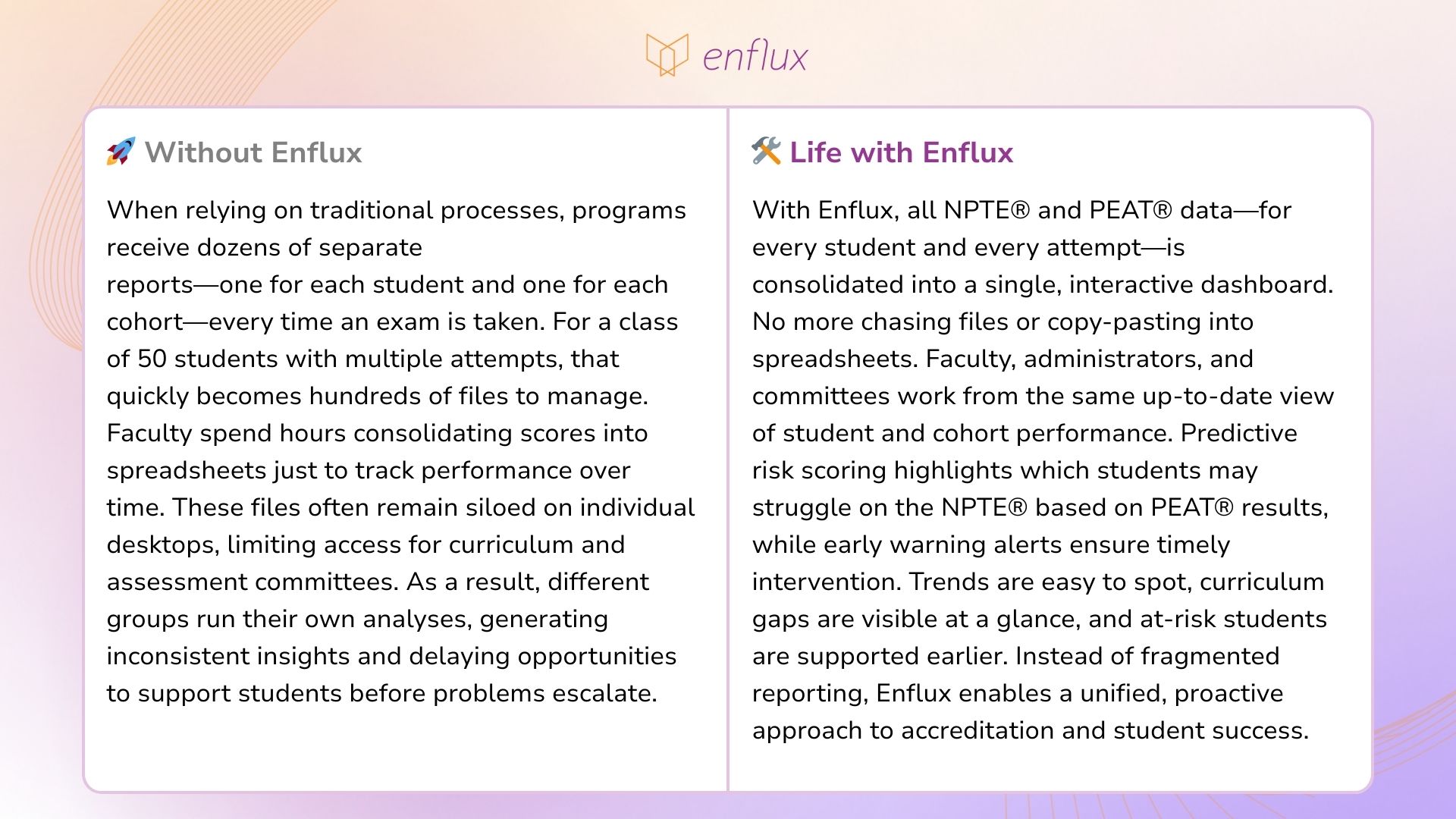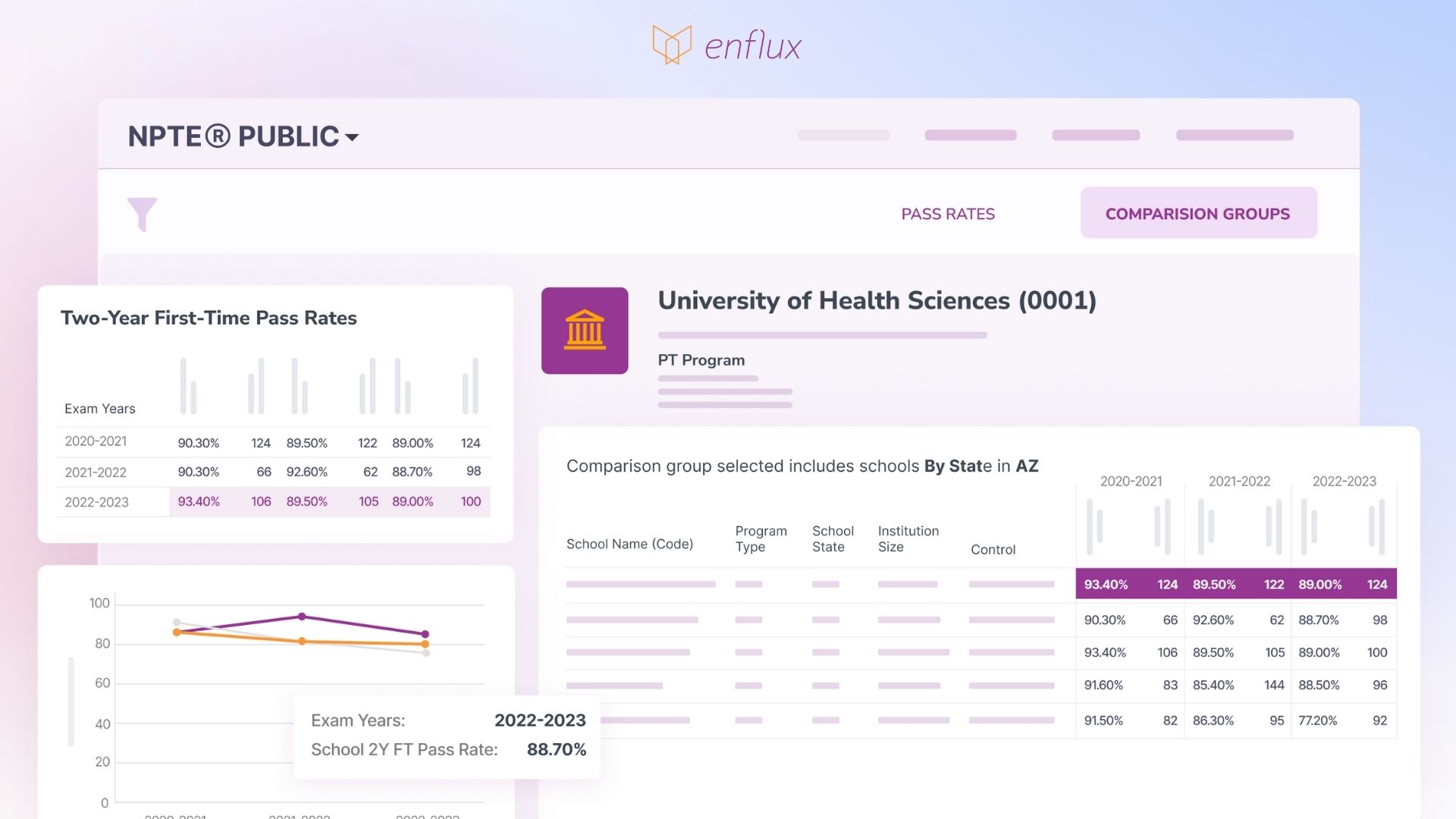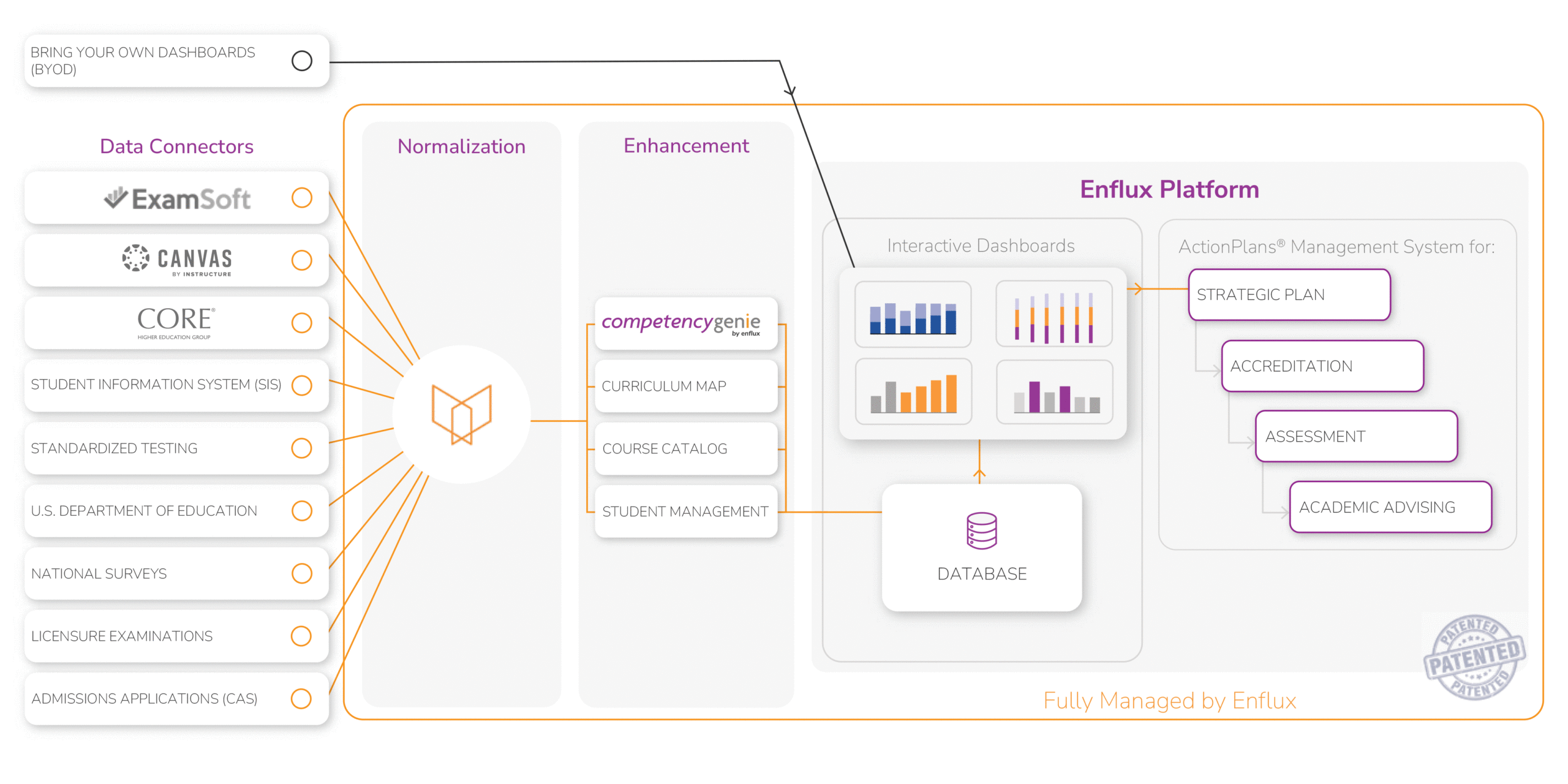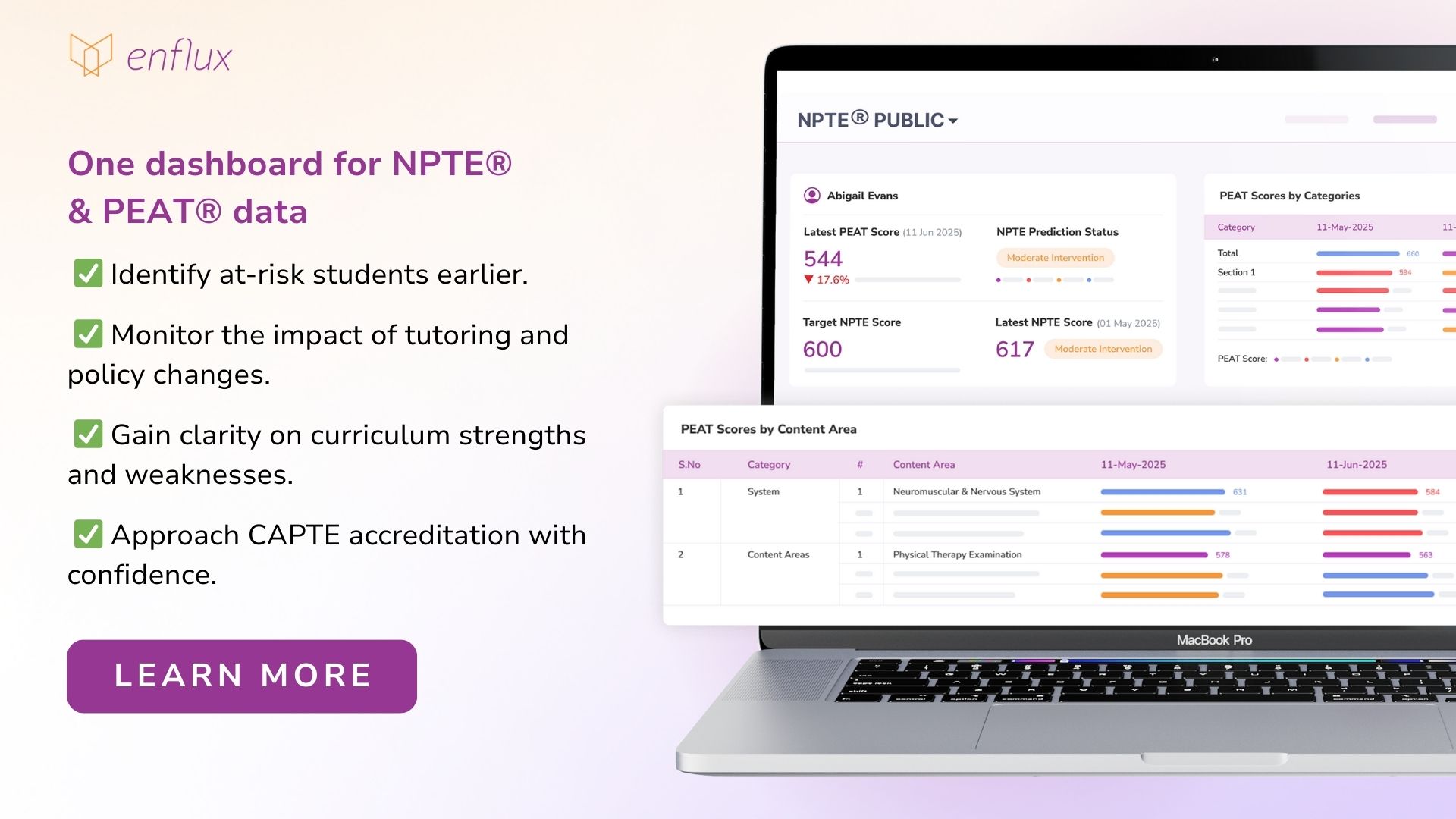
Why Physical Therapy School Accreditation Requires Smarter Learning Analytics Now
Physical Therapy (PT) programs sit at a critical intersection in higher education. Accrediting bodies raise expectations, student demand continues to grow, and the pressure to graduate practice-ready clinicians increases each year. Meeting CAPTE accreditation standards, supporting faculty, and ensuring student success requires time, coordination, and reliable data. Too often, programs rely on outdated or fragmented tools that make the process reactive rather than proactive.
The numbers show the challenge clearly. The first-time NPTE® pass rate averages 85–90% across CAPTE-accredited programs. That means up to 15% of graduates struggle to succeed on their first attempt. With over 300 PT programs and nearly 40,000 enrolled students under CAPTE oversight, even small gaps in physical therapy school accreditation can create major consequences for students and institutions alike.
To advance effectively, physical therapy programs require more than static spreadsheets and fragmented reporting systems. They need an integrated approach to learning analytics that proactively connects student performance, curriculum evaluation, and accreditation compliance within a continuous improvement framework. By systematically analyzing NPTE® and PEAT® data alongside curricular outcomes, smarter physical therapy learning analytics enable earlier identification of student risk, more targeted remediation strategies, and clearer evidence of CAPTE accreditation readiness.
Challenges in physical therapy school accreditation
1. The accreditation burden in CAPTE reviews
While CAPTE accreditation is essential for maintaining program quality and accountability, the process is intensive and resource-demanding. Faculty and administrators devote significant time to compiling evidence, mapping outcomes, and demonstrating compliance with physical therapy accreditation standards. Because much of this work relies on manual effort and fragmented systems, the likelihood of overlooking critical gaps remains high.
2. Curriculum mapping and PT accreditation standards
Physical therapy education is inherently competency-driven, yet curriculum mapping often remains a complex and time-consuming task. Programs must demonstrate where competencies and outcomes are introduced, reinforced, and assessed in alignment with CAPTE accreditation standards. Without precise mapping, redundancies and omissions may weaken program coherence and place physical therapy school accreditation at risk during reviews. Leveraging physical therapy learning analytics can provide the clarity needed to ensure alignment with physical therapy accreditation standards and strengthen the evidence presented in accreditation reports.
3. Faculty burden in accreditation reporting
Physical therapy faculty already balance teaching, clinical responsibilities, and student mentoring. The additional demand of manual accreditation reporting and data analysis compounds their workload, often leading to fatigue and burnout. This administrative burden diverts valuable time away from direct student engagement and undermines the long-term quality of physical therapy education. Streamlined systems aligned with CAPTE accreditation standards are essential to reduce faculty burden while sustaining program excellence.
4. Student readiness and retention
Graduation alone does not guarantee that students are practice-ready. Programs must identify at-risk students early and provide targeted remediation to ensure successful outcomes. Without timely insights, interventions arrive too late, leading to attrition and lower NPTE® pass rates—results that directly jeopardize compliance with CAPTE accreditation standards. Incorporating physical therapy education analytics supports earlier risk detection, more effective remediation, and stronger evidence for physical therapy school accreditation.
5. Fragmented data without clear direction
Most programs collect extensive data, but it is often fragmented across learning management systems, exams, surveys, and spreadsheets. The challenge lies not in access to data, but in converting scattered information into meaningful, actionable insights. Without structured physical therapy learning analytics, programs struggle to connect outcomes with accreditation requirements and risk missing critical evidence in CAPTE accreditation reviews. Integrated dashboards and physical therapy education analytics can transform disparate data into a coherent framework for continuous improvement and accreditation success.
Why smarter learning analytics matter in physical therapy education
Meeting physical therapy school accreditation requirements has never been more demanding. Programs must demonstrate curriculum alignment, track student readiness, and show continuous improvement. Yet many still depend on fragmented spreadsheets and siloed reports, leaving critical gaps undiscovered until CAPTE accreditation reviews are already underway.
Smarter physical therapy learning analytics change this dynamic. Instead of reacting after problems surface, programs can monitor progress continuously and intervene before risks escalate.
Learning analytics for PT schools empower programs to:
- Simplify curriculum mapping with AI-powered tagging and visualization that show where outcomes are taught, reinforced, and assessed—ensuring full coverage without redundancy.
- Stay aligned with CAPTE standards through dashboards that provide ongoing evidence of compliance.
- Detect student risk earlier with indicators that highlight learners at risk of NPTE® underperformance, enabling timely remediation.
- Support faculty engagement by reducing reporting workload and freeing faculty to focus on mentoring and instruction.
- Unify decision-making with a centralized platform that ensures administrators, faculty, and advisors operate from the same source of truth.
This shift from static reporting to dynamic physical therapy education analytics helps programs move beyond compliance-driven activity and focus on continuous improvement in learning outcomes.
Integrate data from your LMS, assessment tools, experiential learning platforms, SIS, national surveys, and internal systems—all in one platform.
Comprehensive physical therapy (PT) learning analytics for accreditation and student success
Physical therapy programs need more than exam scores to succeed with CAPTE accreditation standards. They require a way to connect licensure outcomes, practice exam performance, and curriculum data into one coherent framework. The Enflux NPTE® & PEAT® Monitoring Suite meets this need by combining the NPTE® Public dashboard with the NPTE® & PEAT® dashboard. Together, these tools give PT leaders actionable insights to improve student readiness, strengthen curricula, and approach physical therapy school accreditation reviews with confidence.
- Track current classes and identify weak content areas before the NPTE®.
- Advise more effectively in capstone courses by correlating ExamSoft categories with PEAT® categories to predict at-risk students earlier.
- Monitor curriculum evolution over time to ensure continuous improvement.
- Identify at-risk students earlier, track the impact of tutoring and remediation, and analyze strengths and weaknesses across NPTE® content domains
Programs tell us they would use the suite for tracking current classes, identifying weak content areas before NPTE®, and seeing curriculum evolution over time. As one program leader explained, “It’s a one-shot, organized, visual view of NPTE/PEAT data that makes trends and risks easy to spot.” Another shared, “It consolidates what we already have into an interactive, usable format.”

NPTE® Public dashboard
The NPTE® Public dashboard extends beyond basic pass rate tracking. It provides faculty and administrators with historical context to evaluate performance trends and benchmark outcomes against peer institutions. By analyzing both first-time and ultimate NPTE® pass rates, programs can pinpoint improvement opportunities and measure progress year over year, strengthening evidence for physical therapy accreditation compliance.

NPTE® analytics help you gain program-level insights to understand outcomes in context and benchmark performance against national standards
NPTE® & PEAT® dashboard
The NPTE® & PEAT® Dashboard gives programs a powerful way to transform practice exam results into forward-looking insights. By leveraging the strong correlation between PEAT® and NPTE® performance, the dashboard generates predictive risk scores that estimate the likelihood of success on the licensure exam. This enables faculty and advisors to intervene proactively, rather than waiting until problems surface at the point of testing.
Built as an early warning system, the dashboard flags students whose scores fall below predefined thresholds, allowing timely remediation and targeted support. Distinct stakeholder views ensure that administrators, faculty, and advisors see the most relevant data for their role — from program-wide performance trends to detailed, student-level insights.
By integrating predictive analytics with actionable reporting, the NPTE® & PEAT® Dashboard helps PT programs anticipate risk, guide resource allocation, and maintain alignment with CAPTE accreditation standards while supporting every student’s path to readiness.
The NPTE® & PEAT® Monitoring Suite operates within the broader Enflux learning analytics platform, which consolidates assessment data from multiple systems into a single, comprehensive view. Enflux integrates data from Canvas, CORE, ExamSoft, and other learning systems to give programs a complete picture of performance. Programs can evaluate curriculum effectiveness against physical therapy accreditation standards, tag exam items to PT/PTA competencies, and design actionable strategies to improve outcomes. This integration reduces manual reporting and lowers administrative workload while increasing clarity across faculty, committees, and administrators.
Shaping the future of physical therapy school accreditation
As accrediting bodies become more data-driven, students demand stronger preparation for practice, and universities face growing pressure to demonstrate value, “good enough” data practices are no longer sufficient.
Programs that adopt physical therapy education analytics today will not only reduce faculty burden but also set the pace for shaping the future of the profession. The challenges are clear: accreditation pressure, curriculum complexity, faculty workload, and the imperative to support student readiness. With smarter PT learning analytics, these challenges become opportunities for innovation and leadership.
Enflux equips programs with the tools to meet physical therapy school accreditation requirements with confidence, streamline curriculum design, and support student success at every stage of the academic journey.
Turn data into actionable insights
Achieve accreditation readiness, curriculum clarity, and student success with Enflux dashboards.

